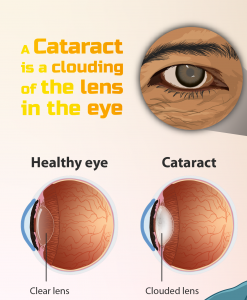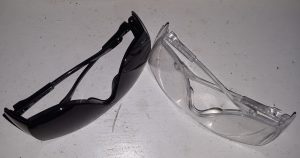When you reach a certain age, you tend to develop cataracts, cloudy lenses. And so it was with me.
And you have the cataracts removed surgically. And so it was with me, I now have brand new, foldable intra-ocular lenses (there are several types). It was a kind of interesting experience all around, and when the unflappable, calming, surgeon-of-the-light-touch Dr. VR suggested I write it up, I did. What follows is based on my own idiosyncratic perceptions, idiosyncratic interpretations, and idiosyncratic memory.
The Surgeries
First, the left eye, OS (oculus, eye; sinister, left)
What do I expect? Going from my knowledge of my mother’s surgery about a decade ago, a longish day at the hospital, a black-box of a surgery-experience, and a fussy, super-careful post-operative schedule of administering eye drops multiple times a day. I fear the black box.
I remember to apply antibiotic drops 6 times a day for 3 days prior to the surgery. What a pain that is! I get multiple reminders from the hospital.
Get to the hospital (with an “attendant”, my sister), start with eye drops to dilate the eyes (mine are recalcitrant and tend to want more dilatant and time); am asked to wash my face (note to self — take a towel next time, they do not have anything to dry yourself with) before going into the ante room outside the operation theatre (here I am separated from said attendant). Wait a bit.
The nurses check that I applied those drops at home, test my BP, drop some medication in my eye, then have me change into a surgery outfit including head cover and covering for the feet. Lie down on a roller stretcher bed. Wait a bit.
Then things seem to happen quite fast, I do remember asking them not to use the heavy sterile face covering that they had at a different time when I had to have an injection in the OS (I am claustrophobic); they say they are using a topical anaesthetic to numb feeling in the eye; I am sure they keep my eye open somehow (how? I don’t think I want to know); then the doctor comes in, he sounds, and is, very reassuring and I occupy (distract?) myself by marvelling at the lights and colours that start dancing in front of my eye. I wish I could paint!
There is this cluster of three points of light (white red and blue?), then I sense that something is in my eye, it has to be the device that was removing the cataract-fluid in the lens, sense some more digging around and manipulation….
In the meantime I am watching the show in front of me, the most striking is the delta, rather like this photo of the Ganga delta. Then I think, Oh, but the delta is reversed! The water is flowing into the narrower veins and toward the pupil, and not away from it, unlike the river delta! I really wish I could paint — what I see is a dark, brown-black background with a bright-yellowish ‘drainage’ system. Very beautiful. Here is a view from the outside. From the inside, only a portion of the circular formation is visible, probably because the other side is being gouged.
And then, while I am marvelling and commenting (aloud) on the show, the doctor says, there, it is over — and so it is!
Then, the right eye, OD (oculus, eye; dexter, right)
Now I know what to expect, right? Not quite. I don’t fear the black box, but…
I forget those antibiotic drops until the day before the procedure (my excuse could be that the date of procedure had to be changed because of my getting Covid-19 during the gap…), and that flusters me a bit. [I am relieved when the nurse at pre-op does not throw me out on my ear, after all. I do not know what Dr VR will think or say, if he reads this.]
The rest of the procedure is just the same, BUT time proceeds so much slower or everything takes longer, and I notice and remember more things. They give me an intravenous injection of mannitol (Really? Did they do that last time??). They leave me on the stretcher bed for a much longer time. I protest longer and harder about the face mask (they are kind enough to lift it a bit on the left so I do not go into a complete panic).
[Interestingly, when I remark on the slowed pace during a follow-up appointment the next day, Dr VR says that most patients feel the same way. Familiarity breeds contempt? It’s all in the mind?]
The experience of the procedure itself is similar the second time; again, I see the lights and the colours and the delta, which is as beautiful as ever; again, I wish I was a painter, and again, it is all over in a jiffy.
After the surgery
The world is MUCH brighter–for a while
… I get an insight into just how much the brain processes the sensory signals it gets from the outside world.
Yup, after the first surgery, the world I see through the left eye is much much brighter than the right. And after the second surgery, the world I see through the right eye is much much brighter than the left. HUH? Is the world just MUCH BRIGHTER OVERALL??
No, and I think this is what happens. After the first surgery, a brain that had got used to a dull post-cataract world (and had started interpreting those signals as ‘normal’), experiences the first, post-surgery, view of the world as BRIGHT!! But then, in the 6+ weeks after the left surgery, the brain has adjusted itself so it now goes back to its ‘normal’, pre-cataract, view of the world. And now the right eye sees a BRIGHT post-surgery world. Aha!! but that miracle may not last long. At three weeks after the second surgery, the world seen via the right still seems brighter. How long will this last? I do not know.
It’s all in the mind?!
The first surgery is more exhausting than the second–or is it?
After the first surgery I am walked out (unsteady) of the OT, wait for a bit, feel very fuzzy and exhausted. My sister is given instructions on how to clean and tend the eye, I am too dazed to notice. We go to my sister’s place, have lunch, and I am dead to the world for a couple of hours. For about 24 hours, I feel drained of energy and much appreciate all the help that is available to me.
After the second surgery, I do not feel even a fraction of the fatigue I did after the left eye, none of the nervousness about caring for the eye, and I know exactly what to do.
IT’S ALL IN THE MIND!!!
The practical stuff
The kitchen
A major thing I remember from my mother’s cataract surgery is “no kitchen, no cooking” (not that she was cooking at that time). So, I am quite surprised when the informational video does not mention the kitchen. Hmmmf, I think to myself in surprise, what about your female patients, dammit? After the first surgery, the nurse does not mention the kitchen being a forbidden area. I ask her, and she says, they caution most patients about this, but not Dr VR’s patients. Why, I ask? Oh, he uses a special procedure. WHAT? I ask him on the follow-up visit, he scoffs at the second question, and about the first, in turn, asks me, do you use a wood fire to cook? Hmm, avoid soot and particulate matter and such, I think to myself.
So, I use a microwave oven to heat up stuff, but do not baulk at putting on the cooker and doing preliminary stuff like that. Definitely avoid being in a steamy hot kitchen. And doing thaalich/tarkaa and such. And frying (which I avoid anyway).
The dark sign of the “de-cataracted”
Yup, I am handed those dark goggles and am warned about not stirring out of the house without them. I can go for a walk, but must always wear them.
While they do tell you that you can read after the surgery, they are a bit vague about reading a book, for example, with those dark goggles on. I suffer through dark goggles after the sinister eye was done, but after the dextrous eye is done, get these nice transparent ones that allow you to function more or less normally.
I plan to use these sometimes in the kitchen in the future to avoid hot splashes etc in the eye. If I remember. And just might discover whether they melt or burn if hot oil splashes on them.
Obviously, there are multiple other concerns and precautions and discoveries, but the ones I describe here are the ones that struck the idiosyncratic me.
==========
In the process of reading a bit while writing this, I came across some interesting reads on the history of cataract — documentation, e.g., in the famous wooden 2500 BCE statue of the Egyptian priest-reader Ka-aper, who may have had cataracts, but such statements have their naysayers; depictions of cataract surgery in Egypt; descriptions of the removal of cataracts by Sushruta (500 BCE) and in continuing western tradition. Overall, it makes me glad that I did not live in 2500 or even 500 BCE.
And as to the connection between the Greek cataract meaning fast-falling, white-foamy water (e.g., waterfalls) and the opaque whiteness of the cataract in eyes…a bit far-fetched, it seems to me.
==========



